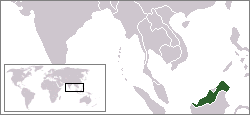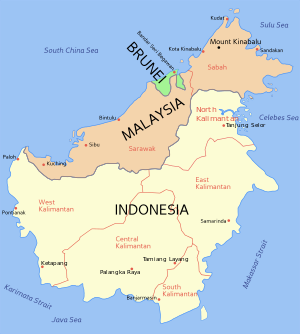
Back شرق ماليزيا Arabic Malasia Oriental AST Subangan na Malasya BCL পূর্ব মালয়েশিয়া Bengali/Bangla Istočna Malezija BS Østmalaysia Danish Ανατολική Μαλαισία Greek Orienta Malajzio Esperanto Malasia Oriental Spanish مالزی شرقی Persian


East Malaysia (Malay: Malaysia Timur), or the Borneo States,[1] also known as Malaysian Borneo, is the part of Malaysia on and near the island of Borneo, the world's third-largest island. East Malaysia comprises the states of Sabah, Sarawak, and the Federal Territory of Labuan. The small independent nation of Brunei comprises two enclaves in Sarawak. To the south and southeast is the Indonesian portion of Borneo, Kalimantan.[2] East Malaysia lies to the east of Peninsular Malaysia (also known as the States of Malaya), the part of the country on the Malay Peninsula. The two are separated by the South China Sea.[3][4]
East Malaysia is less populated and has fewer developed settlements than West Malaysia. While West Malaysia contains the country's major cities (Kuala Lumpur, Johor Bahru, and Georgetown), East Malaysia is larger and much more abundant in natural resources, particularly oil and gas reserves. In the pan-regional style, city status is reserved for only a few settlements, including Kuching, Kota Kinabalu and Miri. Various other significant settlements are classified as towns, including many with over 100,000 residents. East Malaysia includes a significant portion of the biodiverse Borneo lowland rain forests and Borneo montane rain forests.
- ^ "Bill for 'Borneo states' instead of 'East Malaysia'". The Star. 2 December 2021. Retrieved 30 August 2022.
- ^ Commission regulation Official Journal of the European Union
- ^ "Location". Malaysia Travel.org.uk. Archived from the original on 23 September 2010. Retrieved 7 July 2010.
- ^ "Malay Peninsula". HarperCollins Publishers. Retrieved 7 July 2010.